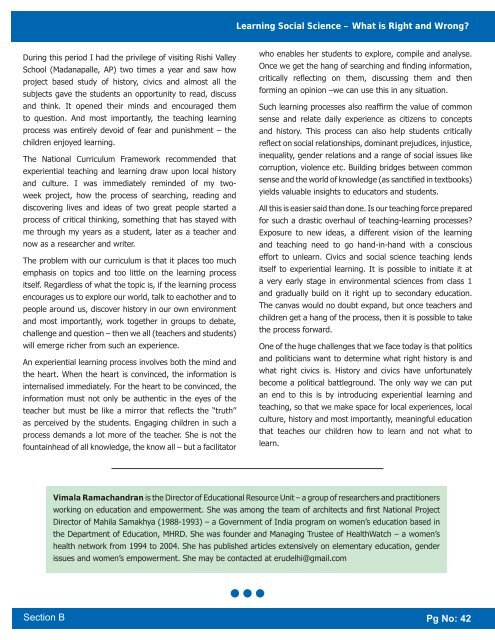Indesign Pagesnew.indd - Azim Premji Foundation
Indesign Pagesnew.indd - Azim Premji Foundation
Indesign Pagesnew.indd - Azim Premji Foundation
Create successful ePaper yourself
Turn your PDF publications into a flip-book with our unique Google optimized e-Paper software.
During this period I had the privilege of visiting Rishi Valley<br />
School (Madanapalle, AP) two times a year and saw how<br />
project based study of history, civics and almost all the<br />
subjects gave the students an opportunity to read, discuss<br />
and think. It opened their minds and encouraged them<br />
to question. And most importantly, the teaching learning<br />
process was entirely devoid of fear and punishment – the<br />
children enjoyed learning.<br />
The National Curriculum Framework recommended that<br />
experiential teaching and learning draw upon local history<br />
and culture. I was immediately reminded of my twoweek<br />
project, how the process of searching, reading and<br />
discovering lives and ideas of two great people started a<br />
process of critical thinking, something that has stayed with<br />
me through my years as a student, later as a teacher and<br />
now as a researcher and writer.<br />
The problem with our curriculum is that it places too much<br />
emphasis on topics and too little on the learning process<br />
itself. Regardless of what the topic is, if the learning process<br />
encourages us to explore our world, talk to eachother and to<br />
people around us, discover history in our own environment<br />
and most importantly, work together in groups to debate,<br />
challenge and question – then we all (teachers and students)<br />
will emerge richer from such an experience.<br />
An experiential learning process involves both the mind and<br />
the heart. When the heart is convinced, the information is<br />
internalised immediately. For the heart to be convinced, the<br />
information must not only be authentic in the eyes of the<br />
teacher but must be like a mirror that refl ects the “truth”<br />
as perceived by the students. Engaging children in such a<br />
process demands a lot more of the teacher. She is not the<br />
fountainhead of all knowledge, the know all – but a facilitator<br />
Section B<br />
Learning Social Science – What is Right and Wrong?<br />
who enables her students to explore, compile and analyse.<br />
Once we get the hang of searching and fi nding information,<br />
critically refl ecting on them, discussing them and then<br />
forming an opinion –we can use this in any situation.<br />
Such learning processes also reaffi rm the value of common<br />
sense and relate daily experience as citizens to concepts<br />
and history. This process can also help students critically<br />
refl ect on social relationships, dominant prejudices, injustice,<br />
inequality, gender relations and a range of social issues like<br />
corruption, violence etc. Building bridges between common<br />
sense and the world of knowledge (as sanctifi ed in textbooks)<br />
yields valuable insights to educators and students.<br />
All this is easier said than done. Is our teaching force prepared<br />
for such a drastic overhaul of teaching-learning processes?<br />
Exposure to new ideas, a different vision of the learning<br />
and teaching need to go hand-in-hand with a conscious<br />
effort to unlearn. Civics and social science teaching lends<br />
itself to experiential learning. It is possible to initiate it at<br />
a very early stage in environmental sciences from class 1<br />
and gradually build on it right up to secondary education.<br />
The canvas would no doubt expand, but once teachers and<br />
children get a hang of the process, then it is possible to take<br />
the process forward.<br />
One of the huge challenges that we face today is that politics<br />
and politicians want to determine what right history is and<br />
what right civics is. History and civics have unfortunately<br />
become a political battleground. The only way we can put<br />
an end to this is by introducing experiential learning and<br />
teaching, so that we make space for local experiences, local<br />
culture, history and most importantly, meaningful education<br />
that teaches our children how to learn and not what to<br />
learn.<br />
Vimala Ramachandran is the Director of Educational Resource Unit – a group of researchers and practitioners<br />
working on education and empowerment. She was among the team of architects and fi rst National Project<br />
Director of Mahila Samakhya (1988-1993) – a Government of India program on women’s education based in<br />
the Department of Education, MHRD. She was founder and Managing Trustee of HealthWatch – a women’s<br />
health network from 1994 to 2004. She has published articles extensively on elementary education, gender<br />
issues and women’s empowerment. She may be contacted at erudelhi@gmail.com<br />
Pg No: 42

















